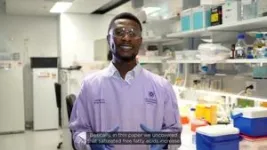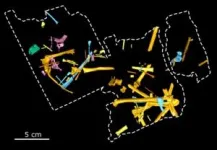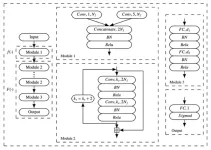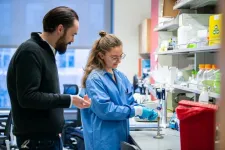(Press-News.org) Researchers at the University of Queensland have revealed the crucial role of saturated fatty acids in the brain’s consolidation of memories.
Dr Isaac Akefe from UQ’s Queensland Brain Institute has uncovered the molecular mechanism and identified the genes underlying the memory creation process, opening the door to a potential treatment for neurodegenerative disorders.
“We’ve shown previously that levels of saturated fatty acids increase in the brain during neuronal communication, but we didn’t know what was causing these changes,” Dr Akefe said.
“Now for the first time, we’ve identified alterations in the brain’s fatty acid landscape when the neurons encode a memory.
“An enzyme called Phospholipase A1 (PLA1) interacts with another protein at the synapse called STXBP1 to form saturated fatty acids.”
The brain is the body’s fattiest organ, with fatty compounds called lipids making up 60% of its weight. Fatty acids are the building blocks of a class of lipids called phospholipids.
The work done in Professor Frederic Meunier’s laboratory has shown that STXBP1 controls the targeting of the PLA1 enzyme, coordinating the release of fatty acids and directing communication at the synapses in the brain.
“Human mutations in the PLA1 and the STXBP1 genes reduce free fatty acid levels and promote neurological disorders,” Professor Meunier said.
“To determine the importance of free fatty acids in memory formation, we used mouse models where the PLA1 gene is removed.
“We tracked the onset and progression of neurological and cognitive decline throughout their lives.
“We saw that even before their memories became impaired, their saturated free fatty acid levels were significantly lower than control mice.
“This indicates that this PLA1 enzyme, and the fatty acids it releases, play a key role in memory acquisition.”
The research has important implications for understanding of how memories are formed.
“Our findings indicate that manipulating this memory acquisition pathway has exciting potential as a treatment for neurodegenerative diseases, such as Alzheimer’s,” Professor Meunier said.
The research team acknowledges the contributions of PhD candidates Saber Abd Elkader from the Australian Institute for Bioengineering and Nanotechnology, and Benjamin Matthews from the Queensland Brain Institute.
This is a collaborative study with the University of New South Wales, University of Strasbourg, University of Bordeaux, The Scripp Research Institute and the Baylor College of Medicine.
The research paper is published in the EMBO Journal.
END
Fatty acids hold clue to creating memories
2024-02-06
ELSE PRESS RELEASES FROM THIS DATE:
Improved differential-neural cryptanalysis for round-reduced Simeck32/64
2024-02-06
Deep learning has led to great improvements recently on a number of difficult tasks.
In CRYPTO 2019, Gohr innovatively integrated deep learning with differential cryptanalysis, specifically applied to Speck32/64, resulting in developing a neural distinguisher that outperforms the DDT-based distinguisher. Applying differential neural cryptanalysis methods to more cryptographic algorithms is an issue worth studying.
To solve the problems, a research team led by Liu ZHANG published their new research on 15 Dec 2023 in Frontiers of Computer Science co-published by Higher Education Press ...
Heavy cannabis use increases risk of developing an anxiety disorder, study suggests
2024-02-06
Ottawa, ON, February 5, 2024 – Twenty-seven percent of individuals who had an emergency department visit for cannabis use developed a new anxiety disorder within three years, according to new research.
Led by researchers at the Bruyère Research Institute, University of Ottawa Department of Family Medicine, The Ottawa Hospital, and ICES, this is the largest study of the relationship between cannabis use and anxiety to date. The study published today in The Lancet’s open access journal eClinical Medicine included over 12 million individuals living in Ontario, Canada, between 2008 and 2019 who had never received a diagnosis or treatment for anxiety. The researchers ...
Amsterdam UMC research shows that ultrasound can be used to detect placenta problems in small babies
2024-02-06
A Doppler ultrasound that measures the blood flow of small unborn babies can reveal whether or not the placenta is working properly. In case of repeated deviations from these Doppler measurements, additional monitoring of the unborn baby is necessary. These deviations indicate a higher risk of oxygen deficiency and other health problems for the baby. This study by Amsterdam UMC in collaboration with UMC Groningen and 17 other Dutch hospitals is published today in the British Journal of Obstetrics & Gynaecology.
Around 10% of unborn babies are classed as small for ...
New species of Jurassic pterosaur discovered on the Isle of Skye
2024-02-06
A new species of pterosaur from specimens found on the Isle of Skye, Scotland, has been announced by scientists from the Natural History Museum, University of Bristol, University of Leicester, and University of Liverpool.
The new pterosaur is part of the Darwinoptera clade of pterosaurs. Its discovery shows that the clade was considerably more diverse than previously thought, and persisted for more than 25 million years, from the late Early Jurassic to the latest Jurassic. During this period species within the clade spread worldwide.
The discovery underpins a new and more complex model for the early evolution of pterosaurs.
The rarity of Middle Jurassic pterosaur ...
Influence of voting advice web tools is limited during elections with authoritarian candidates, study shows
2024-02-06
The influence of online vote advice tools designed to help voters discover more about candidates is limited when elections are affected by authoritarianism, a new study shows.
Voting advice applications offer voters nonpartisan information about political parties, candidates, and policy issues.
The research shows they could be an alternative source of information for those interested in learning about politics in democracies, but their use would be limited in authoritarian settings, particularly in the longer term.
In the short-term, and during highly competitive elections with tiny winning margins for candidates ...
Solving an age-old mystery about crystal formation
2024-02-06
A million years ago, the oldest known species to walk upright like a human, the Homo Erectus, had a human-like fascination with crystals. Historians can even pin down the possible reasons – crystals didn’t look like anything around at the time - trees, valleys, mountains. Crystals were a material to ponder, a fascinating diversion for the mind.
To this day, the human preoccupation with the magic of crystals continues to fill the mind’s eye of scientists who have developed ways to use crystals for everything from malaria cures to solar cells and semiconductors, catalysts and optical elements. Over the years crystals have become crucial constituents ...
New research shows AI dog personality algorithm could match you with your new ‘best friend’
2024-02-06
A multi-disciplinary research team specializing in canine behavior and Artificial Intelligence has developed an AI algorithm that automates the high-stakes process of evaluating potential working dogs’ personalities. They hope to help dog training agencies more quickly and accurately assess which animals are likely to succeed long term in careers such as aiding law enforcement and assisting persons with disabilities. The personality test could also be used for dog-human matchmaking, helping shelters with proper placement, thus reducing the number of animals returned ...
In a warming world, climate scientists consider category 6 hurricanes
2024-02-05
– By Linda Vu
For more than 50 years, the National Hurricane Center has used the Saffir-Simpson Windscale to communicate the risk of property damage; it labels a hurricane on a scale from Category 1 (wind speeds between 74 - 95 mph) to Category 5 (wind speeds of 158 mph or greater).
But as increasing ocean temperatures contribute to ever more intense and destructive hurricanes, climate scientists Michael Wehner of Lawrence Berkeley National Laboratory (Berkeley Lab) and James Kossin of the First Street Foundation wondered whether the ...
Better together: Beckman imaging facilities share $3 million Alzheimer’s research grant
2024-02-05
What do a synthetic chemist, a medical imaging expert, and a neurologist have in common? They’re coming together in the Biomedical Imaging Center at the Beckman Institute for Advanced Science and Technology to develop better diagnostic tools and imaging agents to detect early-stage Alzheimer’s disease and other neurodegenerative diseases.
The dream team
A team led by Liviu M. Mirica along with Wawryzneic “Wawosz” Dobrucki and Dr. Daniel A. Llano received a $3 million grant from the U.S. National Institute on ...
$1.9 million NIH grant to support research on impacts of the microbiome on human health
2024-02-05
UNIVERSITY PARK, Pa. — The bacteria and microorganisms that live within the human body — the microbiota — can impact human health, disease risk and even how the body absorbs medications, but the details of these processes are unclear. To help understand how complex communities of microbes impact human health, the National Institutes of Health’s National Institute of General Medical Science has awarded a 5-year, $1.9 million Maximizing Investigator’s Research Award to Jordan Bisanz, assistant professor of biochemistry and molecular biology in the Penn State Eberly College of Science.
“It is clear that the diversity of microbes in the ...








